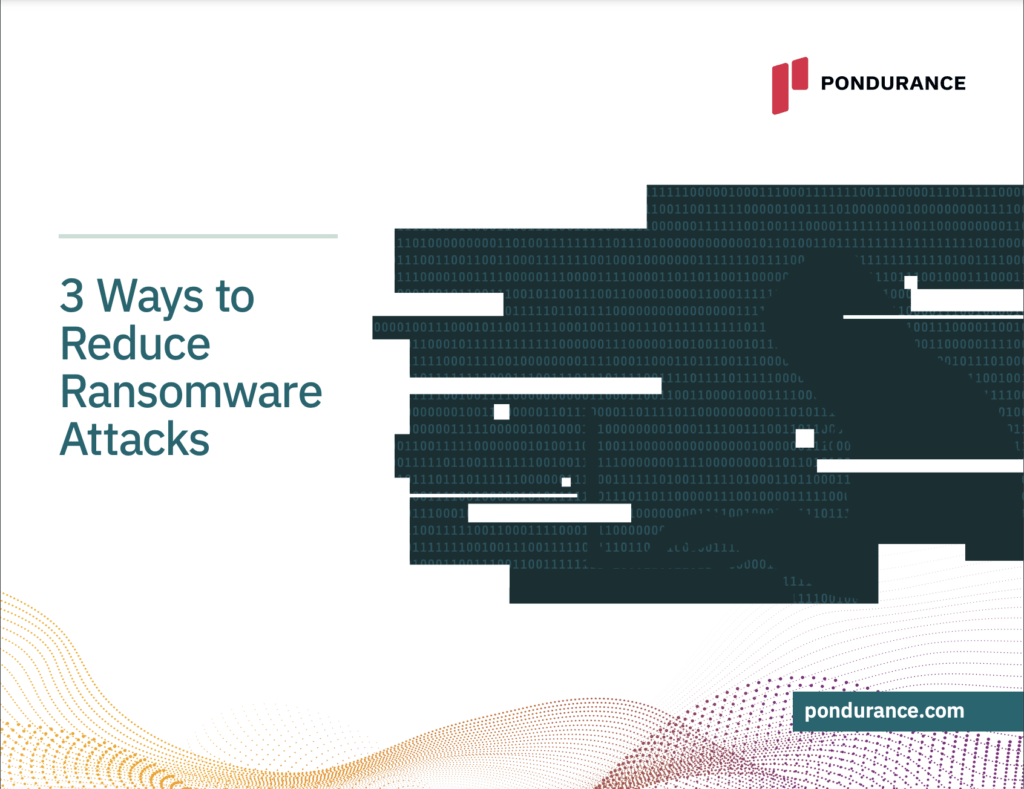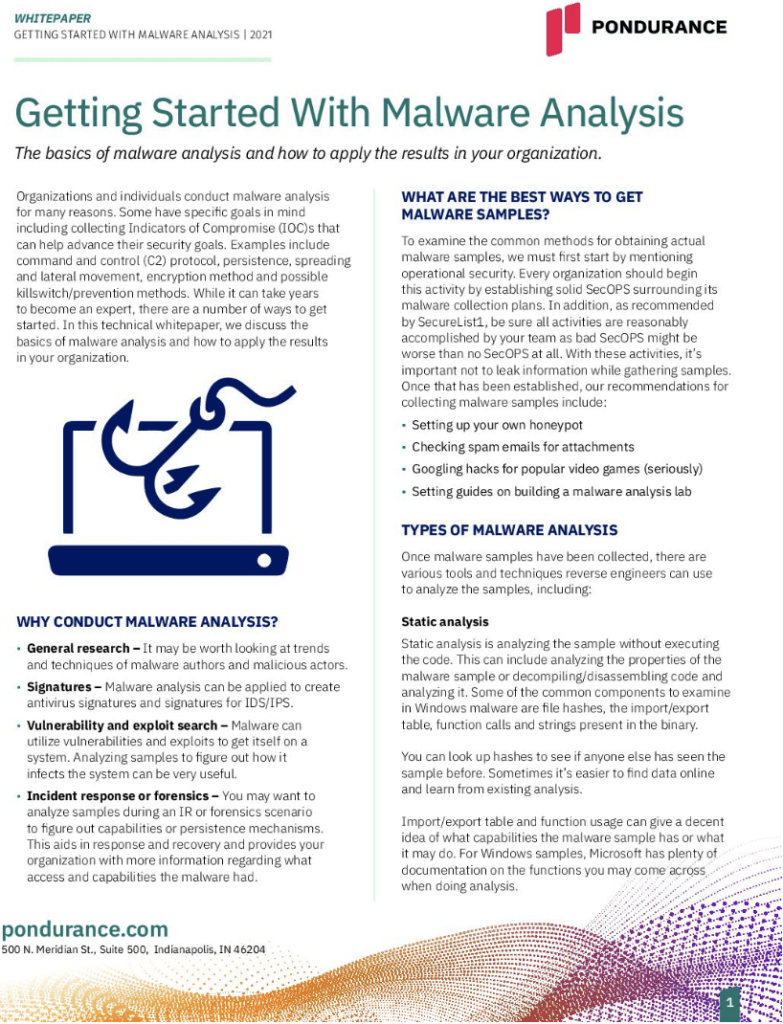Our privacy policy is located here.
Common Attack Vectors
And Keys to Protecting Your Business
Ransomware
- Keep all computers and devices patched
- Enable MFA
- Limit user access
- Allow only authorized applications
- Use network segmentation
- Limit remote access as much as possible
- Establish 360-degree visibility
- Monitor and analyze logs
- Provide consistent security awareness training
- Encrypt endpoints
Identify. Prioritize. Protect.
Malware
- Install reputable antivirus software and ensure it remains up to date
- Regularly update your operating system and all installed applications
- Enable built-in firewalls on your devices
- Be cautious of email attachments and links from unknown sources
- Utilize strong passwords and enable multifactor authentication (MFA) where possible
- Create regular backups of your important files and store them securely offsite
- Employee training – Educate staff members about potential threats such as phishing emails and social engineering tactics employed by cybercriminals
- Network segmentation – Divide your organization’s network into separate zones to minimize the spread of malware should an attack occur
- Vulnerability management – Regularly assess, identify, and remediate vulnerabilities in your IT infrastructure before they can be exploited by attackers
- Incident response planning – Develop a well-defined incident response plan outlining roles, responsibilities, and procedures to follow when faced with a security breach
Ransomware
- Keep all computers and devices patched
- Enable MFA
- Limit user access
- Allow only authorized applications
- Use network segmentation
- Limit remote access as much as possible
- Establish 360-degree visibility
- Monitor and analyze logs
- Provide consistent security awareness training
- Encrypt endpoints
Phishing
Additional Phishing Resources
Spear Phishing
Additional Spear Phishing Resources
Business Email Compromise (BEC)
Additional BEC Resources
How to Protect Against Ransomware
Ransomware, a malicious type of software designed to encrypt an individual or organization’s data, renders it inaccessible until a ransom demand is met. Ransomware attacks, increasingly prevalent across various industries, pose significant risks to cybersecurity. A large-scale survey reveals that more than one-third of companies worldwide have fallen victim to one or more ransomware attacks or breaches in the past year, emphasizing the severity of this cyber risk. Ransomware continues to evolve in sophistication, with cybercriminals employing varied techniques to execute attacks. Initially, ransomware had a single function of encrypting data; however, it has evolved into double extortion tactics, where attackers steal data and threaten to leak it alongside encrypting it for ransom. Understanding the different types of ransomware, their operation, and preventive measures is crucial in securing sensitive information and mitigating potential impacts.
There exist numerous types of ransomware capable of infecting computers and devices, including well-known examples like CryptoLocker, WannaCry, Petya, and Locky. While these attacks may vary in complexity and payloads, they share a common method of utilizing encryption algorithms to lock files or systems. Ransomware typically infiltrates systems through phishing emails containing malicious attachments or links, exploiting vulnerabilities in outdated software or operating systems. Once installed, ransomware initiates file encryption and displays a ransom message demanding payment for decryption.
Prevention is paramount in addressing ransomware threats effectively. A comprehensive ransomware prevention checklist should encompass various security measures such as maintaining up-to-date software patches, implementing strong email filters to thwart phishing attempts, regularly backing up data for swift recovery, and educating users on safe browsing practices. Recommendations from cybersecurity experts like Pondurance stress the importance of measures such as enabling multi-factor authentication, limiting user access, employing network segmentation, and encrypting endpoints to bolster defenses against ransomware.
Cybersecurity organizations like Pondurance offer specialized services aimed at assisting clients in safeguarding against ransomware attacks. Resources such as Ransomware Prevention Checklist PDFs provided by industry experts equip organizations with actionable strategies to fortify their defenses. Understanding the nature of ransomware attacks and implementing proactive measures are pivotal in mitigating their impact. Partnering with cybersecurity experts enhances readiness against the evolving ransomware landscape, ensuring a secure digital environment and peace of mind for businesses and individuals alike.
As ransomware threats continue to evolve, organizations must stay vigilant and proactive in their defense strategies. The consequences of ransomware attacks can be devastating, leading to significant financial losses, operational disruptions, and reputational damage. Therefore, it is essential for businesses to invest in robust cybersecurity measures and collaborate with experienced cybersecurity partners to effectively combat ransomware threats. Additionally, ongoing training and awareness programs can empower employees to recognize and report potential ransomware threats, further strengthening the organization’s overall security posture. By taking a proactive approach to ransomware prevention and response, businesses can mitigate risks and protect their valuable data and assets from malicious cyber threats.
What is Ransomware in Cybersecurity
Ransomware, a significant concern in cybersecurity, involves malicious software encrypting data, demanding ransom for its release. This cyber risk is rampant, causing disruptions, data breaches, and financial losses for victims. To combat such threats, companies must bolster their cyber risk management strategy with informed security teams and robust threat intelligence.
When hit by ransomware, swift action is essential. Following incident response plans like the NIST Ransomware Playbook aids in containment and recovery. However, given the evolving cyber threat landscape, companies often rely on top cybersecurity companies for assistance. These firms offer expertise in threat assessment, informed security, and cyber risk reduction, bolstering organizations’ security postures.
Preventing ransomware entails a multifaceted approach, including regular data backups, software updates, and employee training. Despite these precautions, cyberattacks may still occur, underscoring the need for proactive risk management strategies. Engaging cybersecurity firms for vulnerability management and incident response ensures prompt action against potential threats, safeguarding information systems and sensitive data.
In essence, ransomware underscores the importance of robust cybersecurity measures. By leveraging expert guidance, organizations can fortify their defenses, minimize potential impacts, and effectively navigate the complex landscape of cybersecurity threats.
Furthermore, as the prevalence of ransomware continues to rise, organizations must prioritize continuous improvement in their cybersecurity posture. Regular assessments and updates to security protocols are essential to staying ahead of evolving threats. Collaboration with cybersecurity companies specializing in ransomware defense can provide valuable insights and proactive measures to mitigate risks effectively. By adopting a proactive and adaptive approach to cybersecurity, organizations can enhance their resilience against ransomware attacks and safeguard their critical assets and operations.
Continuous Monitoring and Threat Intelligence
In the ever-evolving landscape of cyber threats, continuous monitoring and leveraging threat intelligence are essential components of an effective ransomware defense strategy. Cybersecurity teams must actively monitor network traffic, system logs, and user behavior for any signs of suspicious activity that could indicate a potential ransomware attack. By utilizing advanced threat detection technologies and threat intelligence feeds, organizations can stay ahead of emerging threats and proactively identify and neutralize ransomware threats before they can inflict damage.
Additionally, threat intelligence allows organizations to gain insights into the tactics, techniques, and procedures (TTPs) employed by ransomware actors, enabling them to tailor their defense mechanisms accordingly and bolster their resilience against evolving cyber threats. Incorporating continuous monitoring and threat intelligence into cybersecurity operations enhances an organization’s ability to detect, respond to, and mitigate ransomware attacks, ultimately safeguarding their critical data and assets from exploitation by cybercriminals.
Continuous monitoring and leveraging threat intelligence are crucial aspects of a comprehensive ransomware defense strategy. By staying proactive and informed about the latest threats and attack methods, organizations can better protect themselves against ransomware attacks and minimize the potential impact on their operations and reputation.
Furthermore, continuous monitoring and threat intelligence enable organizations to anticipate and adapt to the ever-changing tactics of ransomware attackers. By staying abreast of emerging trends and patterns in ransomware attacks, cybersecurity teams can preemptively adjust their defense strategies to mitigate potential risks effectively. This proactive approach allows organizations to stay one step ahead of cybercriminals and minimize the likelihood of successful ransomware attacks.
In addition to bolstering defenses against ransomware, continuous monitoring and threat intelligence play a crucial role in incident response and post-attack analysis. In the event of a ransomware attack, real-time monitoring can help organizations quickly detect and contain the threat, limiting its spread and minimizing damage. Furthermore, by analyzing threat intelligence data collected during and after an attack, organizations can gain valuable insights into the attackers’ tactics, motivations, and infrastructure, allowing them to refine their defenses and better prepare for future threats. This iterative process of learning and adaptation is essential for maintaining resilience in the face of evolving cyber threats.
In navigating the complex landscape of ransomware defense, organizations can benefit greatly from the expertise and support of cybersecurity firms like Pondurance. Pondurance offers specialized services tailored to ransomware defense, including threat intelligence analysis, incident response planning, and proactive threat hunting. By partnering with Pondurance, organizations gain access to seasoned cybersecurity professionals who can provide guidance, resources, and hands-on assistance in fortifying their defenses against ransomware attacks.
Pondurance’s comprehensive approach to ransomware defense encompasses continuous monitoring, threat intelligence integration, and incident response readiness. Leveraging advanced technologies and industry-leading practices, Pondurance helps organizations detect and respond to ransomware threats effectively, minimizing the impact on business operations and mitigating potential damages.
Furthermore, Pondurance’s proactive threat hunting capabilities enable organizations to stay ahead of emerging ransomware threats. By proactively identifying and neutralizing potential threats before they manifest into full-scale attacks, Pondurance helps organizations bolster their resilience against ransomware and maintain a strong security posture.
Incorporating Pondurance into an organization’s ransomware defense strategy provides peace of mind, knowing that experienced cybersecurity professionals are on hand to navigate the challenges of the ever-evolving threat landscape. With Pondurance as a trusted partner, organizations can confidently face the challenges posed by ransomware and safeguard their critical data and assets from exploitation by cybercriminals.
Related Topics
- Mdr Consultant
- Mdr Vs Edr
- What Is Incident Response
- Ransomware Playbook
- Mdr Solution
- How To Prevent Ransomware Attacks
- Incident Response Cybersecurity
- What Is Mdr
- What Is Managed Detection And Response
- Mdr Services
- Managed Detection And Response
- Mdr Cybersecurity
- Nist Incident Response
- What Is Mdr In Cybersecurity
- Spear Phishing
- Cyber Incident Response
- Threat Hunting
- How To Prevent Malware Attacks
- Phishing Attack
- Endpoint Detection And Response
- What Is Malware
- What Is Ransomware
- Security Operations Center

